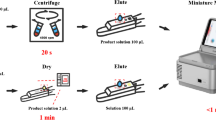Abstract
A capillary electrophoresis-inductively coupled plasma mass spectrometry (CE-ICP-MS) method was developed for separation of the free oxaliplatin drug substance from liposome-entrapped oxaliplatin. Simultaneous determination of phosphorous and platinum opened the possibility to simultaneously monitor the liposomes (phospholipids) and platinum-based drug. In order to suppress the interferences, argon gas was used as a collision gas in ICP-MS. A detection limit of 29 ng/mL of platinum and a precision of 2.9% (for 10 μg/mL of oxaliplatin standard) were obtained. Measurement of the total concentration of free and encapsulated oxaliplatin by CE-ICP-MS was compared with total determination by ICP-MS after microwave digestion and showed a good agreement. A liposomal formulation of oxaliplatin based on PEGylated liposomes was used as a model drug formulation. Studies of accelerated drug release induced by sonication and phospholipase A2 catalyzed hydrolysis were performed. It was demonstrated that the CE-ICP-MS was an efficient in vitro characterization method in the development and quality assurance purposes of lipsome-based formulation of metallodrugs.

Free and liposome-encapsulated platinum drug is distinguished by simultaneous detection of phosphorous and platinum by CE-ICP-MS





Similar content being viewed by others
References
Rosenberg B, Vancamp L, Krigas T (1965) Inhibition of cell division in Escherichia coli by electrolysis products from a platinum electrode. Nature 205:698–699
Di Francesco AM, Ruggiero A, Riccardi R (2002) Cellular and molecular aspects of drugs of the future: oxaliplatin. Cell Mol Life Sci 59:1914–1927
Ranson M, Howell A, Cheeseman S, Margison J (1996) Liposomal drug delivery. Cancer Treat Rev 22:365–379
Torchilin VP (2005) Recent advances with liposomes as pharmaceutical carriers. Nat Rev Drug Discov 4:145–160
Iyer AK, Khaled G, Fang J, Maeda H (2006) Exploiting the enhanced permeability and retention effect for tumor targeting. Drug Discov Today 11:812–818
Metselaar JM, Mastrobattista E, Storm G (2002) Liposomes for intravenous drug targeting: design and applications. Mini Rev Med Chem 2:319–329
Andresen TL, Jensen SS, Jorgensen K (2005) Advanced strategies in liposomal cancer therapy: problems and prospects of active and tumor specific drug release. Prog Lipid Res 44:68–97
Gomez-Hens A, Fernandez-Romero JM (2006) Analytical methods for the control of liposomal delivery systems. Trac-Trends Anal Chem 25:167–178
Torchilin VP, Weissig V (2003) Liposomes. A practical approach. Oxford University, New York
Tam TTNN, Sturup S, Ostergaard J, Franzen U, Gammelgaard B (2011) Simultaneous measurement of phosphorus and platinum by size exclusion chromatography coupled to inductively coupled plasma mass spectrometry (SEC-ICPMS) using xenon as reactive collision gas for characterization of platinum drug liposomes. J Anal At Spectrom 26:1466–1473
Franzen U, Nguyen TTTN, Vermehren C, Gammelgaard B, Ostergaard J (2011) Characterization of a liposome-based formulation of oxaliplatin using capillary electrophoresis: encapsulation and leakage. J Pharmaceut Biomed Anal 55:16–22
Kannamkumarath SS, Wrobel K, Wrobel K, B’Hymer C, Caruso JA (2002) Capillary electrophoresis-inductively coupled plasma-mass spectrometry: an attractive complementary technique for elemental speciation analysis. J Chromatogr A 975:245–266
Yin XB, Li Y, Yan XP (2008) CE-ICP-MS for studying interactions between metals and biomolecules. Trac-Trends Anal Chem 27:554–565
Profrock D, Leonhard P, Prange A (2003) Determination of phosphorus in phosphorylated deoxyribonucleotides using capillary electrophoresis and high performance liquid chromatography hyphenated to inductively coupled plasma mass spectrometry with an octopoles. J Anal At Spectrom 18:708–713
Fujii S, Inagaki K, Chiba K, Takatsu A (2010) Quantification of phosphorus in DNA using capillary electrophoresis hyphenated with inductively coupled plasma mass spectrometry. J Chromatogr A 1217:7921–7925
Michalke B (2005) Capillary electrophoresis-inductively coupled plasma-mass spectrometry: a report on technical principles and problem solutions, potential, and limitations of this technology as well as on examples of application. Electrophoresis 26:1584–1597
Andresen TL, Jensen SS, Kaasgaard T, Jorgensen K (2005) Triggered activation and release of liposomal prodrugs and drugs in cancer tissue by secretory phospholipase A2. Curr Drug Deliv 2:353–362
Andresen TL, Thompson DH, Kaasgaard T (2010) Enzyme-triggered nanomedicine: drug release strategies in cancer therapy (invited review). Mol Membr Biol 27:353–363
Davidsen J, Jorgensen K, Andresen TL, Mouritsen OG (2003) Secreted phospholipase A(2) as a new enzymatic trigger mechanism for localised liposomal drug release and absorption in diseased tissue. Biochim Biophys Acta 1609:95–101
Abe T, Sakamoto K, Kamohara H, Hirano Y, Kuwahara N, Ogawa M (1997) Group II phospholipase A2 is increased in peritoneal and pleural effusions in patients with various types of cancer. Int J Cancer 74:245–250
Ying Z, Tojo H, Komatsubara T, Nakagawa M, Inada M, Kawata S, Matsuzawa Y, Okamoto M (1994) Enhanced expression of group-Ii phospholipase A(2) in human hepatocellular-carcinoma. Biochim Biophys Acta-Mol Basis Dis 1226:201–205
Vikbjerg AF, Petersen SA [DK], Melander F [SE], Henriksen JR [DK], Joergensen K [DK] (2009) Liposomes for drug delivery and methods for preparation thereof. WO2009EP56297 20090525 [WO2009141450 (A2)]. Ref Type: Patent
Moller C, Sturup S, Hansen HR, Gammelgaard B (2009) Comparison of two CE-ICP-MS interfaces and quantitative measurements of carboplatin in plasma samples using an internal standard. J Anal At Spectrom 24:1208–1212
Michalke B, Schramel P (1997) Coupling of capillary electrophoresis with ICP-MS for speciation investigations. Fresenius J Anal Chem 357:594–599
Balsinde J, Balboa MA, Insel PA, Dennis EA (1999) Regulation and inhibition of phospholipase A(2). Annu Rev Pharmacol Toxicol 39:175–189
Acknowledgments
LiPlasome Pharma A/S is gratefully acknowledged for the donation of phospholipase A2 and fruitful discussions.
Author information
Authors and Affiliations
Corresponding author
Rights and permissions
About this article
Cite this article
Nguyen, T.T.T.N., Østergaard, J., Stürup, S. et al. Investigation of a liposomal oxaliplatin drug formulation by capillary electrophoresis hyphenated to inductively coupled plasma mass spectrometry (CE-ICP-MS). Anal Bioanal Chem 402, 2131–2139 (2012). https://doi.org/10.1007/s00216-011-5651-6
Received:
Revised:
Accepted:
Published:
Issue Date:
DOI: https://doi.org/10.1007/s00216-011-5651-6




